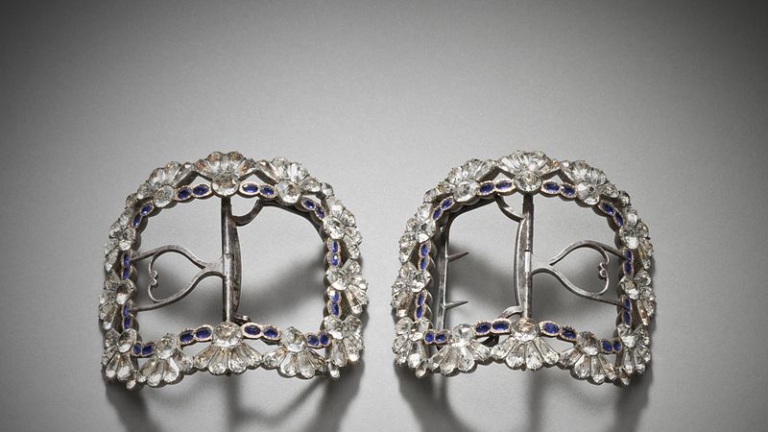From Head to Toe: The Colonial Williamsburg Collection

by Cynthia Howell, First published for the July/August 2011 issue of Finery
One of the real pleasures of the accessories symposium in Williamsburg VA was the opportunity to view the exhibit “From Head to Toe, the Colonial Williamsburg Collection”. The DeWitt Wallace Decorative Arts Museum housed the exhibit in conjunction with symposium. While the exhibit was not huge, it was filled with an array of fascinating objects. The opening display featured a humorous connection between 18th C articles and their modern equivalents. The typical connections between shoes, handbags, and hats were represented, but I think my favorite was the blackberry versus the leather bound almanac complete with needle case and mirror. Although my first visit was interesting, after listening to Linda R. Baumgarten, Williamsburg’s curator of textiles and costume, discuss the items in the exhibit, I decided I had to go back for a more in-depth view.
The exhibit featured a few fully dressed mannequins. It is always lovely to see clothing on display. It is even better to see it in the context of how it would have actually been worn. In the same way that a businessman wouldn’t wear a suit without a shirt and shoes, fully accessorized mannequins convey a complete picture of fashion. I could clearly see the way the neckerchief, apron, mitts or gloves, shoes, stockings, cap and hat would have been worn to complete a woman’s ensemble as well as how a wig, stock, watch strings, shoes, shoe buckles, and walking stick add life to a man’s ensemble.
There was also a treasure trove of whitework objects. Accessories of snowy white cotton and linen, especially if beautifully embroidered, were considered a sign of status and rank. Not only could the wearer afford to purchase the finest quality, but one could also afford the skilled servants necessary to keep the linen washed and pressed. One particularly beautiful apron was cotton embroidered with linen thread in an all-over peacock pattern. Inside two small circles the owner’s name or initials and the year are worked in drawn work. They read “Iane (Jane) Riggs” and “IR 1710.” There were several stunning examples of sleeve ruffles, including one that had never been made up. I think my favorite piece was something I had dismissed on my first visit. A falling collar (see picture below) that would have been used to fill the neckline of a Regency gown wasn’t of particular interest, until I heard that it started its life as a set of engageantes and was then converted for a more modern use.

Handkerchiefs were an important accessory for all social classes in the 18th century. Printed handkerchiefs could be used for sneezes, to tie around the neck, or to proclaim political or personal beliefs. There is a wonderful printed handkerchief entitled “The Century of Invention, Anno Domini 2000”. It is a forward view to vehicles of the 21st C; steampunk fans should find that of particular interest. Women also wore neck handkerchiefs, or kerchiefs, as fashion accessories.
Pockets, purses and workbags were essential for toting things around and keeping track of small items. I think many of us are familiar with pockets; I was fascinated by the variety of workbags, pocketbooks and wallets. Many of these items were lavishly decorated with embroidery and spangles. One pocketbook is a bit of a mystery. The outer clasp appears to be from the late 18th C, but the interior clasp is from the 1860s. A woman’s workbag from 1760-1780 is a model of ingenuity. It is covered in cream silk embroidered with metallic thread and trimmed with sequins, enameled metal and silver lace. Instead of being a simple square of soft fabric, it appears to be made of pasteboard and is teardrop shaped. It even has a cunning drawer that opens off the side. I’d love to carry my sewing gear in something so stylish.
Men’s accessories were equally elaborate. Men often removed their wigs and wore soft caps instead. There are many examples of gorgeously embroidered, highly decorated caps in the exhibit. Mark Hutter, Williamsburg’s journeyman tailor, believes that these decorated caps were given as gifts, potentially to mark special occasions, such as marriage or the birth of children. He has not seen any period portraits of men actually wearing these caps. Most portraits show a man wearing a simple tube of fabric gathered with a ribbon at the top.
Men wore strips of fine white linen or cotton tied around their necks, or stocks that were gathered or pleated, for formal occasions. Stocks would have tabs at the back that would buckle or tie. One side of the tab would have worked buttonholes that would line up with the knobs on the stock buckle. Stocks with hanging tabs of fabric were called short bands and clergymen or barristers most often wore them. Stock buckles could be simple metal or elaborately bejeweled. One of the stocks in the exhibit has an astounding 62 inches of fabric gathered onto a 3-inch tab.
No ensemble would be complete without shoes and shoe buckles. Shoe buckles were designed to be easy to transfer between shoes. They could be a simple metal oval, or could be have elaborate curlicues and be set with paste jewels. Shoe buckles could be expensive and often came in their own specially made cases. A set that once belonged to John Minson Galt is included in the exhibit. The buckles are completely ringed with paste stones and include the case, which had been relined and inscribed by a family member.
I came away from my visits to the exhibit reeling from the exquisite details lavished on these everyday items. Accessories do really make the man or woman, and help convey social standing. Gaining additional information about the exhibit deepened my appreciation of items it contained and inspired me to make more accessories of my own.
For more information, or really fantastic pictures, browse the online exhibit at: http://www.history.org/history/museums/clothingexhibit/index.cfm




Leave a comment